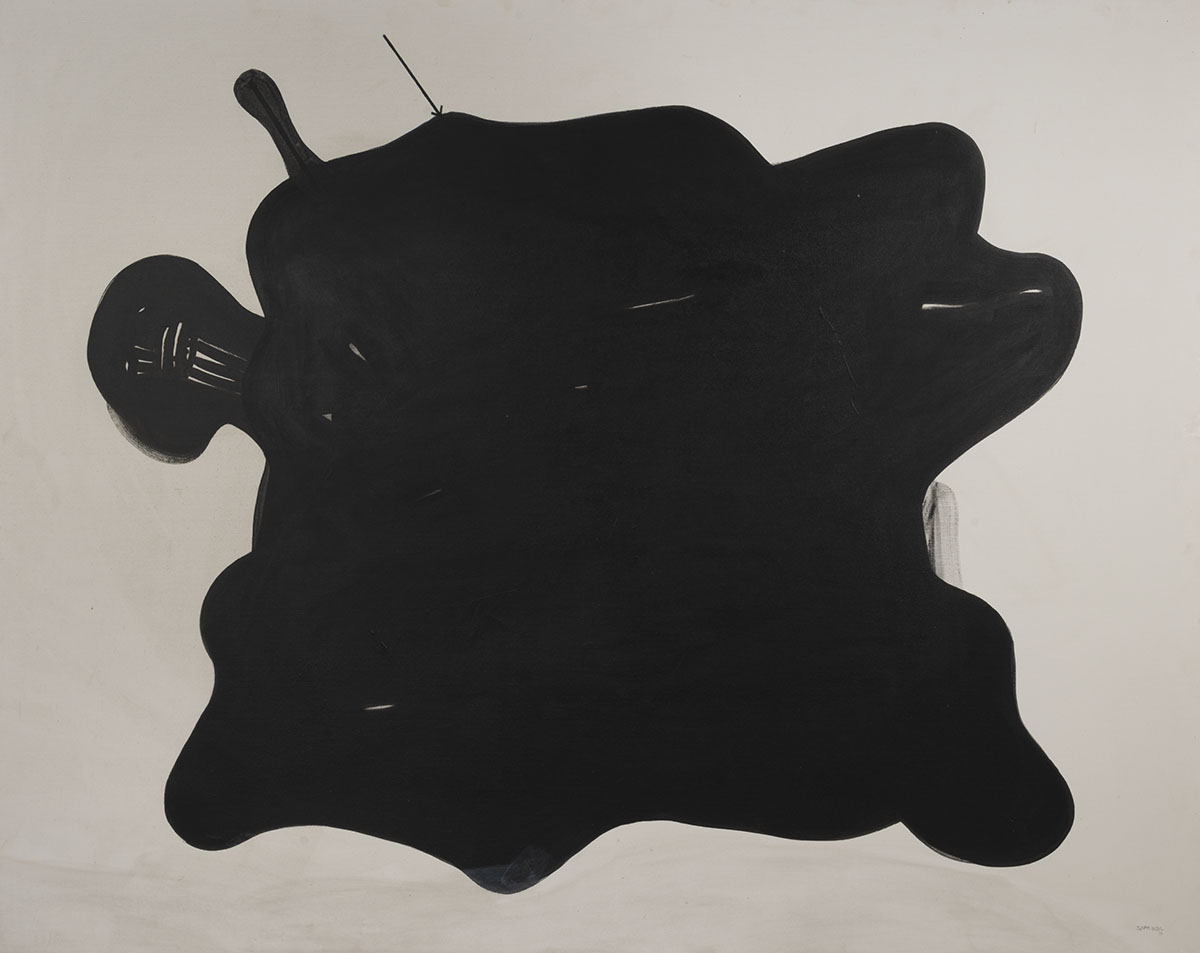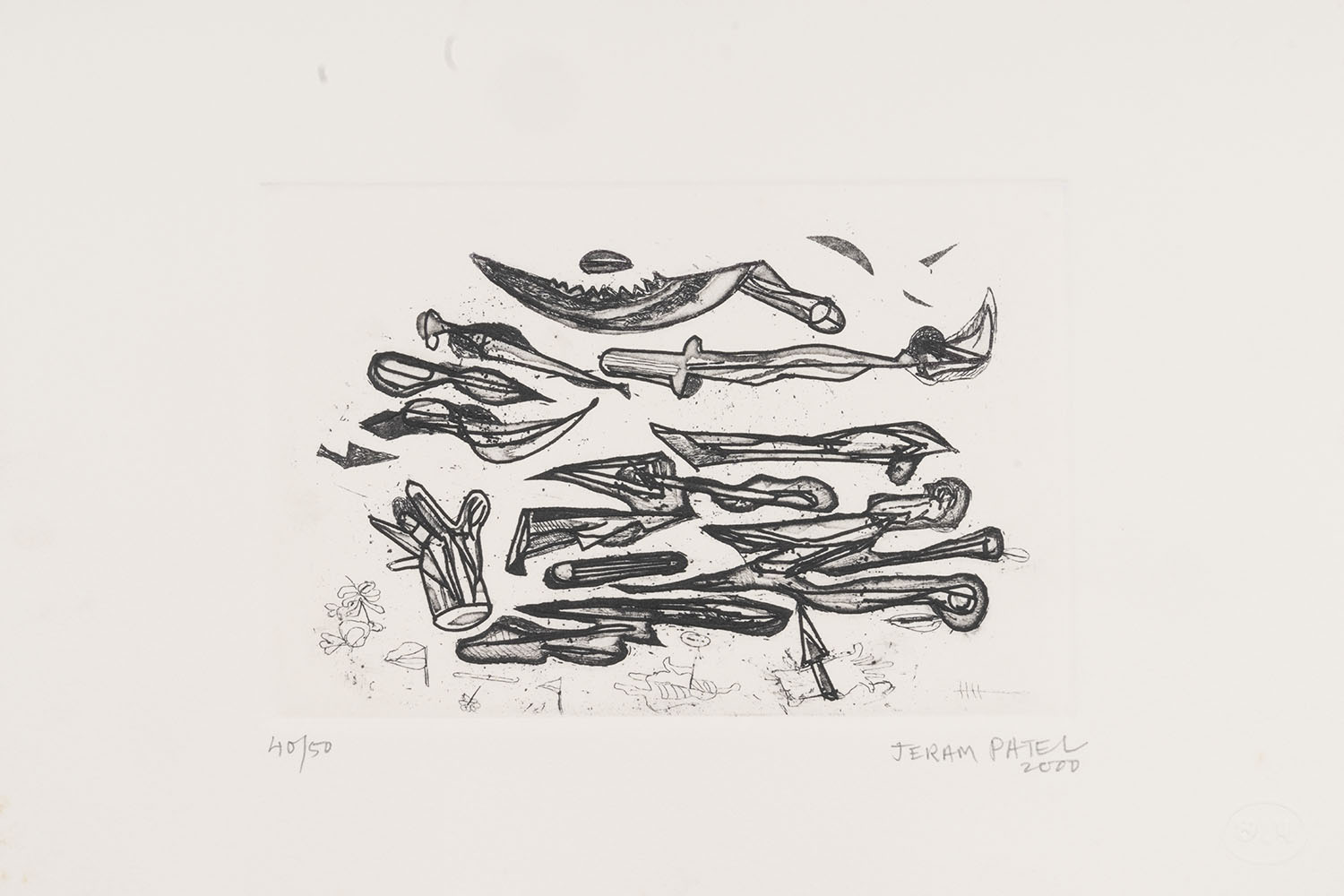ARTICLE
Jeram Patel
Modernist artist and founding member of Group 1890, Jeram Patel is known for his abstract ink drawings and burnt wood engravings.
Born in Kheda, Gujarat, Patel studied drawing and painting at Sir JJ School of Art, Mumbai (1950–55) and typography and publicity design at the Central School of Arts and Craft, London (1957–59). In 1960, Patel joined the Faculty of Fine Arts, Maharaja Sayajirao University (MSU), Baroda (now Vadodara), where he taught artists such as Anil Relia and Malti Gaekwad. He also briefly taught at the National Institute of Design (NID), Ahmedabad, and served as Deputy Director of the Handloom Board of India (1963–66). In 1980, he became a fellow of the Royal Society of Arts, London.
Patel’s early works are figurative, executed in black ink, as in the Hospital series (1966), rendered in black and white using a crow quill and ink on handmade paper. Following a trip to Japan in the 1960s, he began experimenting with engravings on burnt plywood. He exhibited his burnt wood panels, Gestalts, at the Group 1890 exhibition of 1963. Patel employed a wide variety of techniques to execute an “attack on wood” through methods such as charring and puncturing. He also used enamel paint on canvas, board, tin sheets and plywood, and employed nails, blowtorch, crow quill, Chinese ink and Japan black. A large number of his artwork remains untitled, driven by his desire to have the material speak for itself, without drawing any references or classifications.
He held his first solo show at Woodstock Gallery, London (1959). He has also shown his works at Gallery One, London (1967); Jehangir Art Gallery, Mumbai (1969); Rabindra Bhavan, New Delhi (1977); National Gallery of Modern Art (NGMA), New Delhi (1994); and the Lalit Kala Akademi, New Delhi (1968, 1975, 1978, 1982). In 2016, the Kiran Nadar Museum of Art (KNMA), New Delhi, organised a retrospective of his work, showing nearly 180 works created by Patel over his artistic career.
In 1994, Patel received the Emeritus Fellowship along with Himmat Shah from the Ministry of Human Resource Development, Government of India. In the same year, he was appointed Chairman of the Lalit Kala Akademi, Gujarat. He received the Kala Ratna (1997) and four National Awards for Rasikapriya (1957), Study in Silence (1963), Black III (1973) and Organic Black (1984).
Patel died in 2016 in Vadodara.
Bibliography
Our website is currently undergoing maintenance and re-design, due to which we have had to take down some of our bibliographies. While these will be re-published shortly, you can request references for specific articles by writing to hellomapacademy@map-india.org.








![The façade of the Maneckji Seth Agiary, a Zoroastrian fire temple, is a standout example of the popularity of the Persian Revival Style in Western India in the 19th and 20th centuries. This style was often seen in the architectural patronage of the Parsis, who emerged as one of the most influential mercantile communities of British India. Popular motifs of this style, like the mythical lamasus (winged bulls with human heads) and the faravahar (a winged guardian spirit in Zoroastrianism), drew on the historical art and architecture of the Achaemenid and Sasanian empires from sites like Persepolis, Bisotun, Taq-e Bostan, Naqsh-e Rostam and Naqsh-e Rajab in Persia.
The Parsi community’s adoption of this style occurred largely due to their networks of global commerce and politics, allowing them to access and translate research of ancient Persia into visible symbols that underlined their association with antiquity, imperial power, and art.
نمای آتشکدهی زرتشتی مانِکجی سِت نمونهی بارزی از رواج سبک «احیای [معماری] ایرانی» در غرب هند طی سدههای نوزدهم و بیستم است. این سبک غالباً در بناهایی دیده میشد که پارسیان، از بانفوذترین جوامع بازرگان در هند بریتانیا، بانیشان بودند. نقشمایههای محبوب این سبک، مانند گاو بالدار اساطیری (لاماسو) و فَروَهَر (روح بالدار نگهبان در دین زرتشت)، برگرفته از هنر و معماری شاهنشاهی هخامنشی و ساسانی، در جاهایی چون تخت جمشید و بیستون و طاق بستان و نقش رستم و نقش رجب، بود.
اقتباس جامعهی پارسیان از این سبک بسیار مرهون روابط گستردهی تجاری و سیاسی آنها بود که دسترس به پژوهشها دربارهی ایران باستان و برگردانیدن آنها به نمادهای بصری را ممکن میکرد و بر پیوند پارسیان با دوران باستان و قدرت شاهنشاهی و هنر تأکید میکرد.](https://mapacademy.io/wp-content/plugins/instagram-feed/img/placeholder.png)
